Kennington Bioscope at The Cinema Museum
23 May 2018
(Warning: Contains Spoilers)
 Star billing at this evening’s Kennington Bioscope presentation went to Polish born silent film diva Pola Negri in The Spanish Dancer, her first major success following her inevitable move from Europe to Hollywood. But before the night’s main feature there was a selection of rare shorts on 16mm, introduced by film collector, editor and director Christopher Bird.
Star billing at this evening’s Kennington Bioscope presentation went to Polish born silent film diva Pola Negri in The Spanish Dancer, her first major success following her inevitable move from Europe to Hollywood. But before the night’s main feature there was a selection of rare shorts on 16mm, introduced by film collector, editor and director Christopher Bird.
 First up was Paris To Monte Carlo in Two Hours (1905), a film from Georges Melies in which a man and his chauffeur make the journey between the two cities by car. Prior to setting off they manage to run down a policeman, literally squashing him flat before using the car’s pump to re-inflate him (image below) until he explodes. Seen off by crowds from in front of the Paris Opera House, they also run down a postman (played by Melies himself), engage in an explosive argument with a Dijon tax collector (Melies again) and cross the Alps, leaving an increasingly long trail of disaster in their wake, before finally crashing into
First up was Paris To Monte Carlo in Two Hours (1905), a film from Georges Melies in which a man and his chauffeur make the journey between the two cities by car. Prior to setting off they manage to run down a policeman, literally squashing him flat before using the car’s pump to re-inflate him (image below) until he explodes. Seen off by crowds from in front of the Paris Opera House, they also run down a postman (played by Melies himself), engage in an explosive argument with a Dijon tax collector (Melies again) and cross the Alps, leaving an increasingly long trail of disaster in their wake, before finally crashing into  the welcoming stand in Monte Carlo.
the welcoming stand in Monte Carlo.
This was a clever and amusing little film, utilising many of the techniques Melies had perfected in earlier pictures. Alternatively known as An Adventurous Automobile Trip, the film pokes fun at Belgium’s King Leopold II who was renowned for driving (and frequently crashing) fast sports cars. Melies was contracted by the Folies Bergere to make the film in 1904, which was then used as part of a stage performance combining live action and a movie sequence. The film featured trick sequences and an animated section, with numerous scenes being hand tinted. It was particularly successful, playing at the Folies over 300 times, after which Melies decided to release the film into cinemas where it again proved a popular success. A version was subsequently released in the United States where the central character was explicitly identified as King Leopold unlike the French version where he had remained anonymous, apparently in order not to damage Franco-Belgian relations. Also of note, during the scene outside the Opera House, a character appears in hugely over-size boots. This may have been the renowned British music-hall star Little Tich, who worked the Paris theatre circuit and made a number of films in France although another source claims it was in fact a French Little Tich imitator known as Little Pich.
(NB Paris To Monte Carlo in Two Hours is available on a number of Melies compilation discs as well as being watchable on-line in a couple of versions.)
We then had Miss Deceit (1915) a rare survivor from the Hepworth Studios in which company owner Podgmore (Jonny Butt) and his accounts clerk Whatley (Arthur Staples) are competing for the affections of Miss Elysia de Seete (Chrissie White). When Whatley notices that Elysia has an eye for a man in uniform he decides to enlist. Podgmore does the same only to discover that he is now junior to Whatley who relishes putting him through his paces. But before the two newly uniformed soldiers can charm Miss de Seete, they discover that she has married the recruiting sergeant!.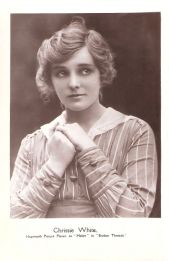
Made in 1915, when World War One army recruitment was still being met by enlistment rather than conscription, this was a gentle and rather amusing comedy directed by Frank Wilson. Female lead Chrissie White (image, left) was a hugely popular star at Hepworth, making some 180 films from as early as 1908, including starring alongside Alma Taylor in the long- running and wildly anarchic series of Tilly girl films (image, right).
running and wildly anarchic series of Tilly girl films (image, right).
When Cecil Hepworth’s studios went bankrupt in 1924 the company was not only sold off for a fraction of its worth but all of the original studio negatives were melted down to reclaim the silver. Further losses resulted from Cecil Hepworth’s own decision to make a bonfire of many of his own (highly inflammable) surviving copies as a precaution during World War Two air-raids. As a result, very few examples of Hepworth films remain and it is possible that the 16mm version being screened this evening is the only surviving copy – anywhere! – of Miss Deceit.
(NB Not surprisingly, no sign of Miss Deceit on disc or on-line.)
 The third short of the evening was the earliest surviving film version of Dr Jekyll and Mr Hyde, made in 1912 (two earlier versions, one made in the USA in 1908 and another made in Denmark in 1910 are both now considered lost films). In this version, Dr Jekyll (image, left) undertakes his research purely for scientific reasons but gradually the Hyde character takes over. When Hyde accosts Jekyll’s fiance her father, the minister, comes to her aid but is killed. Chased back to Jekyll’s laboratory by the police, Hyde (image, below) escapes capture by reverting to Jekyll but realising that he is inevitably destined to become trapped for ever as
The third short of the evening was the earliest surviving film version of Dr Jekyll and Mr Hyde, made in 1912 (two earlier versions, one made in the USA in 1908 and another made in Denmark in 1910 are both now considered lost films). In this version, Dr Jekyll (image, left) undertakes his research purely for scientific reasons but gradually the Hyde character takes over. When Hyde accosts Jekyll’s fiance her father, the minister, comes to her aid but is killed. Chased back to Jekyll’s laboratory by the police, Hyde (image, below) escapes capture by reverting to Jekyll but realising that he is inevitably destined to become trapped for ever as 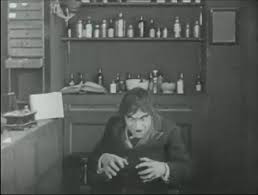 Hyde he takes poison with the police closing in.
Hyde he takes poison with the police closing in.
By far the weakest of this evening’s three short openers, this version of R l Stephenson’s story is hampered by some shocking ‘ham’ acting. Lead character James Cruze clearly realised his movie talents lay elsewhere and would soon switch from acting to directing, with considerably more success, putting together a resume that would include a classic western The Covered Wagon (1923), comedy Merton of the Movies (1924), racy melodrama The Mating Call (1928) and early sound drama The Great Gabbo (1929). As Jekyll’s fiance, Florence le Badie was on her way to becoming a major star but in 1917, with almost 200 films to her name, she was killed when the brakes of her car failed, the first major female film star to die while her career was at its peak.
(NB I can’t find Dr Jekyll and Mr Hyde on disc but it is watchable on-line in several versions.)
Piano accompaniment for these three films came from John Sweeney who coped admirably with the rapidly shifting genres, from fantasy to comedy to horror.
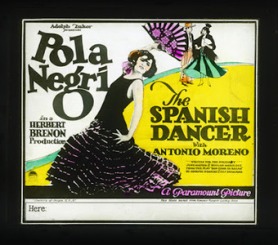 Then it was time for the evening’s main feature, The Spanish Dancer starring the one and only Pola Negri as Maritana, the spirited gypsy dancer and fortune teller. Set in 17th century Spain, Maritana and the penniless nobleman Don Cesar de Bazan (Antonio Moreno) are attracted to one-another when she dances at his banquet. Maritana fights a duel with another gypsy for the return of Bazan’s purse which had been stolen and when Bazan is pursued by creditors she helps him escape (image, below), promising to meet him again at a forthcoming festival in Madrid.
Then it was time for the evening’s main feature, The Spanish Dancer starring the one and only Pola Negri as Maritana, the spirited gypsy dancer and fortune teller. Set in 17th century Spain, Maritana and the penniless nobleman Don Cesar de Bazan (Antonio Moreno) are attracted to one-another when she dances at his banquet. Maritana fights a duel with another gypsy for the return of Bazan’s purse which had been stolen and when Bazan is pursued by creditors she helps him escape (image, below), promising to meet him again at a forthcoming festival in Madrid.
Meanwhile, in the court of King Philip IV (Wallace Beery), intrigue surrounds a French proposal for closer links with Spain. Philip’s French wife Queen Isabel (Kathlyn Williams) supports an alliance but the King’s advisor Don Salluste (Adolphe Menjou) is suspicious of French intentions. The King is also tiring of his wife and seeks new conquests.
As the festival in Madrid begins, Philip goes out amongst the crowd in disguise where he sees and is beguiled by Maritana. He sends orders that she be traced and brought before him. Bazan also meets up with Maritana but is then arrested as he draws his sword to protect a young apprentice Juan (Robert Agnew) from being mistreated. When Bazan  is sentenced to death Maritana implores Isabel to have him released (having previously earned the Queen’s favour by saving her son from a runaway horse).
is sentenced to death Maritana implores Isabel to have him released (having previously earned the Queen’s favour by saving her son from a runaway horse).
But Maritana and Bazan’s relationship is now caught up in wider palace intrigues. Philip will only countenance a relationship with Maritana if she is of nobility so he plans to have her secretly marry Bazan before he is executed. For his part, Salluste hopes to scupper any alliance with France by sowing discord between king and queen so he informs Isabel that Philip is entertaining Maritana at his hunting lodge. Meanwhile Bazan, having now been married to Maritana, manages to escape the firing squad thanks to Juan’s help and also makes his way to the hunting lodge to save his bride. As Philip and Bazan prepare to fight over Maritana the sudden arrival of Isabel prompts Philip to claim  that he is merely blessing the relationship between the newly wed couple. King and queen are reconciled as are Maritana and Bazan. But things don’t look so good for Salluste!
that he is merely blessing the relationship between the newly wed couple. King and queen are reconciled as are Maritana and Bazan. But things don’t look so good for Salluste!
OK, so The Spanish Dancer isn’t a classic and if we’re being honest it doesn’t even really fall into the ‘very good’ category. Its over long with a hugely convoluted plot and Wallace Beery is certainly no Philip IV! On a more positive note, it is well directed by Herbert Brenon who does indeed keep the plot this side of comprehensible and the big crowd scenes are well handled and hugely spectacular (thanks in no small part to James Wong Howe’s superb camera work). But the key element in the film’s favour is the presence of ‘La Negri’. Pola lights up the picture with her every scene, be it dancing, fighting a duel, leaping on a horse or just suffering for love. She proves that  there is more to acting than just being a vamp and her earlier dance training is used to superb effect in her portrayal of the sultry and seductive Maritana
there is more to acting than just being a vamp and her earlier dance training is used to superb effect in her portrayal of the sultry and seductive Maritana
Starting out in life as Barbara Appolonia Chalupiec, born in 1897 in what is now Poland but was then part of the Russian empire, Negri grew up in poverty. But when she displayed a talent for dance she was lucky enough to be accepted by the Imperial Ballet School. When illness put an end to her dancing career she switched instead to acting, changing her name along the way to Pola Negri (Pola, short for Appolonia, and Negri, after Italian novelist and 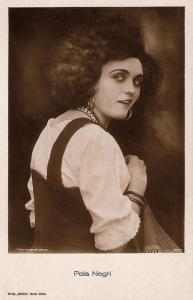 poet Ada Negri). She made her first stage appearance in 1913 and soon after began a career in film, starting with Slave of Sin (aka Niewolnica zmyslów, Dir. Aleksander Hertz, 1914), the first ever Polish feature film, which is sadly now considered lost. Her first Polish film known to have survived was The Polish Dancer (aka Bestia, Dir. Aleksander Hertz, 1917).
poet Ada Negri). She made her first stage appearance in 1913 and soon after began a career in film, starting with Slave of Sin (aka Niewolnica zmyslów, Dir. Aleksander Hertz, 1914), the first ever Polish feature film, which is sadly now considered lost. Her first Polish film known to have survived was The Polish Dancer (aka Bestia, Dir. Aleksander Hertz, 1917).
Appearing on stage in Berlin in 1917 (where she co-starred with Ernst Lubitsch), Negri was signed by German studio Saturn Films for whom she made six pictures before  moving to the larger Universum-Film AG (UFA) studios where she starred in a string of successful Lubitsch directed pictures including Carmen (1918), Madame DuBarry (re-titled Passion for the US market, 1919) and The Wildcat (1921).
moving to the larger Universum-Film AG (UFA) studios where she starred in a string of successful Lubitsch directed pictures including Carmen (1918), Madame DuBarry (re-titled Passion for the US market, 1919) and The Wildcat (1921).
The success of these films in America led to Negri being contracted by Famous Players (Paramount) in 1921, the first big European star signed by Hollywood, in effect blazing a trail for the likes of Vilma Banky, Greta Garbo and Marlene Dietrich who were soon to follow. Her first two films in America, Bella Donna and The Cheat (both 1923 and directed by George Fitzmaurice), were somewhat disappointing but then came The Spanish Dancer.
Paramount had been planning a film called The Spanish Cavalier, based on the novel Don Cesar de Bazan by Adolpho Philippe Dennery and Philippe Francois Pinel, as a starring vehicle for Rudolph Valentino. But he was in contract dispute with the studio so writers Beulah Marie Dix and June Mathis rewrote the screenplay in order that the focus of the story becomes the gypsy dancer Maritana and Negri was offered the role. She wanted Lubitsch to direct but he had already been loaned to Mary Pickford’s United Artists Studio to direct her in Rosita (image, right), ironically another version of the very same source novel as The Spanish Dancer. Instead, Paramount put director Herbert Brenon in charge. Although he and Negri did not get along (to say the least!) the completed film was both a critical and popular success, far outshining Pickford and Lubitsch’s Rosita. According to reviews of the time, much of this success was down to to Negri’s exhilarating performance, typified by the San Antonio Express proclaiming that “Negri comes back and is again the Negri that so electrified the world in ‘Passion’”
focus of the story becomes the gypsy dancer Maritana and Negri was offered the role. She wanted Lubitsch to direct but he had already been loaned to Mary Pickford’s United Artists Studio to direct her in Rosita (image, right), ironically another version of the very same source novel as The Spanish Dancer. Instead, Paramount put director Herbert Brenon in charge. Although he and Negri did not get along (to say the least!) the completed film was both a critical and popular success, far outshining Pickford and Lubitsch’s Rosita. According to reviews of the time, much of this success was down to to Negri’s exhilarating performance, typified by the San Antonio Express proclaiming that “Negri comes back and is again the Negri that so electrified the world in ‘Passion’”
With this success under her belt, Negri luxuriated in the role of diva with a string of high-profile romances, a wardrobe full of fabulous outfits, a white Rolls Royce and a pet cheetah. Further success firmly established her by the middle of the decade amongst the top-rank (and top paid) 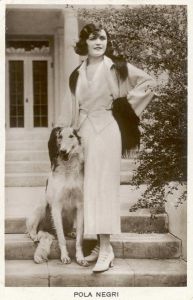 stars in Hollywood. But it was all to prove transitory. Her over extravagant display of grief at the funeral of lover Rudolph Valentino provoked charges of bad taste and publicity hunting. Then there were a string of poorly performing films and a new husband who was secretly spending her money on a series of ill-fated business ventures. Eventually her contract with Paramount was not renewed and after a number of international and German productions Negri gradually drifted into retirement.
stars in Hollywood. But it was all to prove transitory. Her over extravagant display of grief at the funeral of lover Rudolph Valentino provoked charges of bad taste and publicity hunting. Then there were a string of poorly performing films and a new husband who was secretly spending her money on a series of ill-fated business ventures. Eventually her contract with Paramount was not renewed and after a number of international and German productions Negri gradually drifted into retirement.
Amongst other stars in The Spanish Dancer, Wallace Beery (image, below right with Adolpho Menjou) was not only wildly miscast as Philip IV but also forced to wear a ludicrous wig which made it hard to take him  even remotely seriously. Although largely forgotten now Spanish born Antonio Moreno, playing Don Cesar de Bazan, was a major silent star. Appearing in minor roles in early Griffith films such as The Musketeers of Pig Alley (1912) and Judith of Bethulia (1914), by 1915 he was the well known star of numerous Vitagraph serials , often playing opposite Norma Talmadge and was frequently typecast as ‘the Latin Lover’ long before the likes of Ramon Navarro or Rudolph Valentino appeared on the scene. As Bazan he nicely plays up the amiable but penniless nobleman.
even remotely seriously. Although largely forgotten now Spanish born Antonio Moreno, playing Don Cesar de Bazan, was a major silent star. Appearing in minor roles in early Griffith films such as The Musketeers of Pig Alley (1912) and Judith of Bethulia (1914), by 1915 he was the well known star of numerous Vitagraph serials , often playing opposite Norma Talmadge and was frequently typecast as ‘the Latin Lover’ long before the likes of Ramon Navarro or Rudolph Valentino appeared on the scene. As Bazan he nicely plays up the amiable but penniless nobleman.  Dublin born director Herbert Brenon (image, left directing Negri) turned out over 120 films (often also as writer) beginning in 1912. The Spanish Dancer was by far his most ambitious project to date with its complex story-line, spectacular settings and cast of over 2,500. The film’s success led to further high profile films such as Beau Geste and The Great Gatsby, both in 1926, and Sorrell and Son (1927) for which he was nominated for an Academy Award. With the arrival of the talkies, Brenon returned to Britain where he directed a string of low budget comedies and dramas until his eventual retirement in 1940.
Dublin born director Herbert Brenon (image, left directing Negri) turned out over 120 films (often also as writer) beginning in 1912. The Spanish Dancer was by far his most ambitious project to date with its complex story-line, spectacular settings and cast of over 2,500. The film’s success led to further high profile films such as Beau Geste and The Great Gatsby, both in 1926, and Sorrell and Son (1927) for which he was nominated for an Academy Award. With the arrival of the talkies, Brenon returned to Britain where he directed a string of low budget comedies and dramas until his eventual retirement in 1940. 
So perhaps not a classic, but The Spanish Dancer was an enjoyable romp, a costume drama which gradually morphed into a costume comedy/drama as the film proceeded. With a superb performance from Pola Negri the film was hugely entertaining in a Princess Bride (1987) sort of way.
Adding enormously to enjoyment of the film was a superb live accompaniment from pianist Meg Morley which beautifully caught both the grand spectacle and great drama of the film as well as the humour and the more intimate moments.
(NB The Spanish Dancer is available on disc from Reelclassicdvd.com. Only trailers and short clips appear to be are available on-line.)
